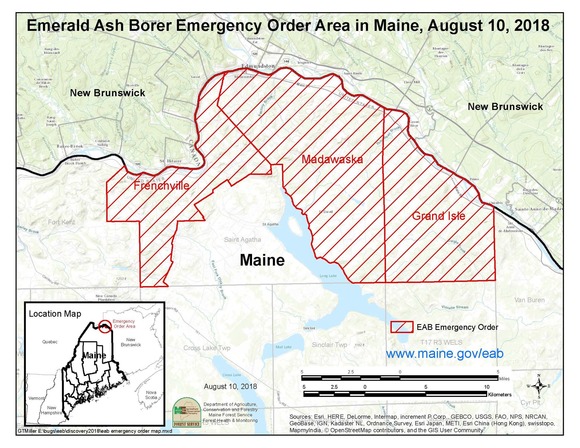|
AUGUSTA - The Maine Department of Agriculture, Conservation and Forestry's (DACF) Bureau of Forestry Director has issued an Emergency Order to Stop Movement of Ash in response to the detection of emerald ash borer (EAB) in northern Aroostook County. The Emergency
Order restricts the movement of certain ash (Fraxinus spp.) products and any untreated firewood from
emerald ash borer (EAB) infested towns in Maine.
Current Order Area Towns: Frenchville, Grand Isle and Madawaska,
Aroostook County, Maine.
To protect the ash resources of the state of Maine from the unrestricted spread and establishment of a dangerous tree-killing forest pest, the Director of the Maine Bureau of Forestry has taken action and issued the Order pursuant to authority granted by 12 M.R.S. § 8305. The full text of the order is available on the Department's EAB information page: www.maine.gov/eab.
BACKGROUND
The
emerald ash borer is a highly destructive, introduced pest of forest
and ornamental ash trees (Fraxinus spp.). Since its initial
detection in southeastern Michigan near Detroit in the summer of 2002
it has spread rapidly. As of August
2018, it has been found in 35 states, and 4 Canadian provinces.
Ash
trees infested with EAB may die within two to three years. From 2002 to 2018, EAB has killed hundreds of
millions of ash trees in infested states and provinces, and has cost
municipalities, property owners, nursery operators and forest products
industries hundreds of millions of dollars.
In
response to the significant ecological and economic threat posed by EAB, Canada
and the state of Michigan established EAB quarantines in 2002. In 2003, the United
States Department of Agriculture—Animal and Plant Health Inspection Service (USDA-APHIS)
established a federal quarantine to restrict movement of potentially infested
material.
Federally regulated materials
include:
The emerald
ash borer; firewood of all hardwood (non-coniferous) species; nursery stock,
green lumber, and other material living, dead, cut, or fallen, including logs,
stumps, roots, branches, and composted and uncomposted chips of the genus
Fraxinus.
Unless infested states
restrict internal movement of potentially infested ash material, the federal
government will designate the entire state as a quarantined area, which
designation will subject the state to federal regulations restricting interstate
and international commerce of ash material.
In
late May 2018, an established EAB infestation was detected in Edmundston, New
Brunswick, Canada, approximately 500 yards from the Maine border (www.maine.gov/eab). Subsequent multi-agency surveys detected
lightly-infested ash trees in Maine immediately across the river from the Edmundston
infestation. The infested ash trees
were located in Madawaska, immediately adjacent to the Frenchville town line.
In early-August purple trap surveys revealed that EAB is also established in the town of
Grand Isle. The detected infestation in
Maine is very light and covers only a small area. If immediate steps are not taken to contain
the infestation, however, this infestation will spread.
Following
the initial detection, the Department of Agriculture, Conservation and Forestry
(DACF), Bureau of Forestry, also known as the Maine Forest Service (MFS), reached
out to all contacts on active commercial timber harvest operations, firewood dealers,
and nursery and plant sellers within Madawaska and Frenchville and apprised
them of the situation. The DACF also
notified local municipal officials and legislators. The DACF held a meeting in Frenchville to
discuss the implications of the situation with local residents and
businesses. At this meeting, and in
subsequent correspondence and media coverage, the DACF informed residents that
a stop movement order was planned for early August after the MFS conducted additional
delimitation surveys and sought additional comments.
Ash trees comprise
4 percent of Maine’s hardwood forest, are a valuable timber species, and are
also an important street tree. EAB threatens all species of ash trees (except
mountain ash) and could have significant ecological and economic impacts on the
state. There are no practical means to control EAB in forested areas, though
pesticide treatments can protect individual trees.
To assist wood processors in complying with the order requirements, the MFS will provide a list through e-mail distribution of active forest operations within the order area. Requests to be added to this list should be directed to forestinfo@maine.gov.
An informational meeting on Emerald Ash Borer is planned in northern Aroostook County for August 23, 2018 @ 6:30 pm, location TBD.
Parties interested in receiving updates regarding emerald ash borer in Maine can subscribe to the Department’s electronic bulletin list "Emerald Ash Borer (EAB)." Subscriptions are available through e-mail or text message (SMS) at https://public.govdelivery.com/accounts/MEDACF/subscriber/new.
Department of Agriculture, Conservation and Forestry Contacts:
- Allison Kanoti, Acting State Entomologist, Maine Forest Service, Allison.M.Kanoti@maine.gov, (207) 827-1813 or
- Gary Fish, State Horticulturist, State Plant Regulatory Official, Plant Health, Gary.Fish@maine.gov, (207) 287-7545

| 


